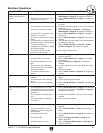
-24-
G9743 7" x 12" Metal-Cutting Bandsaw
The speed at which the saw blade will cut through
a workpiece is controlled by blade type
, feed rate,
and feed pressure
.
Note
: If a lubricant is used on the cut, the feed
rate can be increased by approximately 15%
.
To set the feed rate:
1. Raise the headstock to the maximum height
to remove spring tension. Close the ON/OFF
valve to lock the headstock in place.
2. Using a 14mm wrench, adjust the feed
pressure tension sprin
g. Tighten enough to
remove play but not enough to apply tension
to the spring (
see Figure 20).
Note: This spring adjustment is an initial set-
ting. Depending on cutting circumstances,
you will have to fine-tune the feed pressure
with this adjustment. Increasing the spring
tension will reduce the feed pressure.
Figure 22. Reading chip characteristics.
Chips are
silvery,
thin, small, or
powdery: Increase
feed rate.
Chips are large,
curled, blue or
brown, or
smoking:
Decrease feed rate.
Chips are width
of tooth, thin and
curled, and silvery
:
Optimum speed and
feed rate.
Feed Rate
3. Clamp the workpiece in the table vise.
4. Close the feed ON/OFF valve Figure 21, to
lock the headstock and blade a few inches
above the workpiece
.
Figure 20. Spring tension adjustment.
Spring
Adjustment Nut
Figure 21. Feed rate dial.
Feed Rate Dial
ON/OFF Valve
5. With the correct saw blade and blade speed
selected, turn the saw and lubricant p
ump
ON.
6. Slowly rotate the feed rate dial clockwise to a
slow feed rate
until the saw begins to cut the
workpiece (see Figure 21).
7. Observe the chips that exit the cut, and
increase or decrease the feed rate according
to the chip
characteristics (see Figure 22).


















